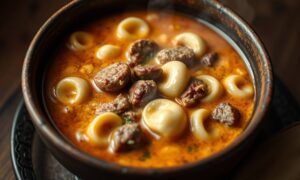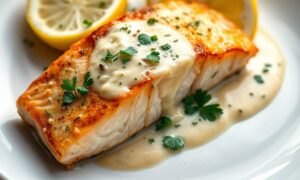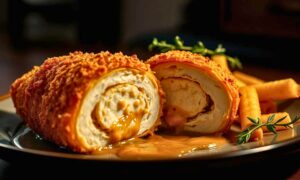Ever tasted a bowl of pasta that feels like summer in every bite? That’s the magic of Pesto Pasta Salad fresh, flavorful, and incredibly satisfying. Picture this: tender pasta coated in rich, herby pesto, tossed with juicy cherry tomatoes, crisp veggies, creamy cheese, and a splash of zesty lemon. It’s light, it’s vibrant, and it delivers big on taste with minimal effort.
Whether you’re prepping for a sunny picnic, a weekend barbecue, or just want something quick and refreshing for lunch, this dish fits the bill perfectly. It’s a crowd favorite that’s easy to make and even easier to love.
In this guide, you’ll learn exactly how to craft the ultimate Pesto Pasta Salad what ingredients to use, how to get the perfect texture, and creative add ins to boost flavor. If you’re craving something simple, nourishing, and totally delicious, you’re in the right place. Get ready to turn a humble bowl of pasta into a celebration of fresh flavors!
I still remember the first time I tasted a proper pesto pasta salad. It was at a little trattoria in Liguria, Italy’s basil growing region, where the owner insisted I try her “insalata di pasta al pesto” before my main course. That first forkful, bright, herbaceous, with perfectly al dente pasta, fundamentally changed how I approached cold pasta dishes forever. It’s one of those dishes that seems deceptively simple but contains multitudes of flavor when prepared with care.
1. Ingredients & Substitutions
For the Pesto
- 2 cups fresh basil leaves, packed (about 2 large bunches)
- ½ cup freshly grated Parmigiano Reggiano cheese
- ⅓ cup pine nuts, lightly toasted
- 3 medium garlic cloves, peeled
- ½ cup extra virgin olive oil (use the good stuff here)
- 1 tablespoon fresh lemon juice
- ½ teaspoon kosher salt
- ¼ teaspoon freshly ground black pepper
For the Pasta Salad
- 1 pound (450g) pasta (fusilli, farfalle, or orecchiette work best)
- 1 pint cherry tomatoes, halved
- 1 medium cucumber, seeded and diced
- 1 small red onion, thinly sliced
- 8 ounces (225g) fresh mozzarella pearls (or diced if using larger mozzarella)
- ½ cup Kalamata olives, pitted and halved
- ¼ cup toasted pine nuts (for garnish)
- Extra basil leaves (for garnish)
Ingredient Notes & Substitutions
The beauty of pesto lies in its adaptability. Traditional Genovese pesto calls specifically for Ligurian basil, which has smaller, more aromatic leaves than common sweet basil. But don’t stress if you can’t source it regular sweet basil works wonderfully too.
For those with nut allergies, sunflower seeds or pepitas create a surprisingly similar texture and nutty depth as pine nuts. The flavor profile shifts slightly, but the structural integrity of the sauce remains intact. Truly, the difference is barely noticeable in the finished dish.
Cheese alternatives? Pecorino Romano provides a more assertive, saltier bite than Parmigiano Reggiano. For dairy free versions, nutritional yeast offers that umami quality, though you’ll want to reduce the quantity to about 3 tablespoons since its flavor is more concentrated.
When selecting pasta, texture retention is key. Fusilli’s spirals catch pesto in their grooves, while farfalle (bowties) provide flatter surfaces that showcase the vibrant green sauce. The pasta shape isn’t just aesthetic it fundamentally affects how the sauce distributes throughout the salad.
2. Step by Step Instructions
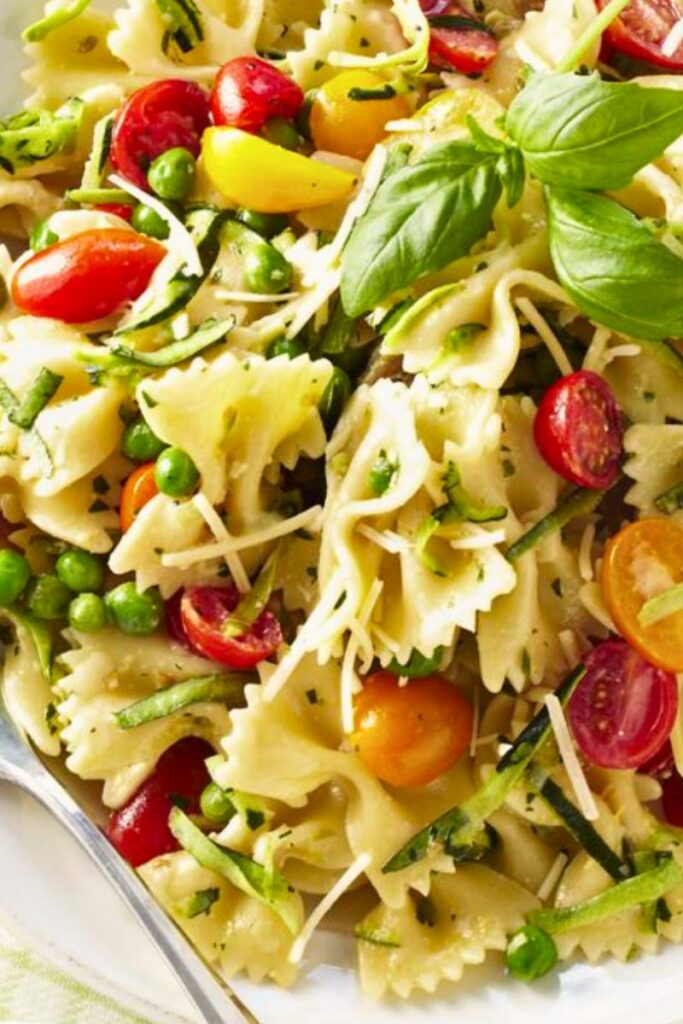
Preparing the Pesto
- Toast the pine nuts in a dry skillet over medium low heat, watching carefully and shaking occasionally until they’re fragrant and golden brown, about 3-5 minutes. Don’t walk away they go from perfect to burnt in seconds! Set aside a quarter cup for garnishing the final dish.
- Prepare an ice bath by filling a bowl with ice and water. Blanch the basil by plunging it into boiling water for just 5-10 seconds, then immediately transfer to the ice bath. This step is optional but helps maintain that vibrant green color that often gets lost when pesto oxidizes.
- Combine ingredients in food processor by adding the basil, garlic, pine nuts, and cheese. Pulse several times until coarsely chopped. With the machine running, slowly drizzle in the olive oil through the feed tube until fully incorporated. Add lemon juice, salt and pepper, then pulse a few more times to combine. Taste and adjust seasoning as needed.
A common mistake is over processing the pesto until it becomes a completely smooth paste. You should actually aim for a somewhat chunky texture where you can still identify bits of basil and pine nuts. This provides textural interest and allows the individual flavors to shine through.
Preparing the Pasta Salad
- Cook the pasta in heavily salted water (it should taste like sea water) until just past al dente, about 1 minute longer than the package instructions. Since the pasta will firm up when chilled, slightly softer pasta works better for cold preparations. Drain thoroughly and spread on a baking sheet to cool quickly, drizzling with a little olive oil to prevent sticking.
- Combine pasta and pesto while the pasta is still slightly warm, not hot, but warm enough to absorb the flavors of the sauce. This crucial temperature sweet spot helps the pasta actually absorb some of the flavorful oils rather than just coating the exterior.
- Fold in remaining ingredients gently, starting with the vegetables and finishing with the mozzarella. Mix just enough to distribute evenly without breaking down the more delicate components. If serving immediately, garnish with additional pine nuts and torn basil leaves.
For make ahead preparation, reserve about 1/4 cup of the pesto and add it just before serving to refresh the flavors. Cold temperatures dull our perception of seasoning, so you might need an extra pinch of salt when serving chilled.
3. Cooking Techniques & Science
The brilliance of pesto pasta salad lies in understanding the science of flavor infusion and temperature effects. When pasta cools, its starch molecules undergo retrogradation, essentially recrystallizing and becoming firmer. This is why pasta salad often tastes better after resting; the ingredients have time to meld while the pasta achieves that perfect chilled firmness.
Blanching basil (that quick dip in boiling water followed by an ice bath) works by neutralizing the enzymes responsible for oxidation. These enzymes, polyphenol oxidase, specifically cause browning when damaged plant cells are exposed to oxygen. The brief heat treatment deactivates these enzymes, preserving that vivid green color for days longer than untreated basil.
Another technique worth mentioning is toasting the pine nuts. This process isn’t just about texture it’s a flavor transformation through the Maillard reaction. The complex chemical interaction between amino acids and reducing sugars creates new flavor compounds, turning the mild, creamy flavor of raw pine nuts into something nutty, complex and aromatic.
The traditional mortar and pestle method for making pesto actually creates different flavor compounds than a food processor. The crushing action, rather than the cutting action of blades, releases different oils and enzymes. If you have time and inclination, try this method for an even more authentic result. You’ll taste layers of flavor that simply don’t develop with mechanical processing.
4. Serving & Pairing Suggestions
Pesto pasta salad reaches its peak flavor at room temperature rather than straight from the refrigerator. Take it out about 20-30 minutes before serving to allow the olive oil to loosen up and flavors to bloom. This temperature shift makes an astonishing difference in how vibrant the dish tastes.
For presentation, consider serving in a wide, shallow bowl rather than a deep dish. This allows guests to see the beautiful colors and textures. A light drizzle of your best olive oil just before serving adds a glossy finish and fresh flavor boost.
When it comes to pairings, think Mediterranean. A crisp Italian white wine like Vermentino or Pinot Grigio complements without overwhelming the herbal notes. For non alcoholic options, a sparkling water infused with cucumber and lemon mirrors the fresh, bright qualities of the salad.
Turn this side dish into a complete meal by adding:
- Grilled chicken or shrimp for protein
- Roasted vegetables like zucchini, eggplant, or bell peppers
- Cannellini beans for a vegetarian protein option
- Slices of prosciutto or sopressata for a more substantial antipasto style presentation
The salad works beautifully alongside grilled foods, particularly seafood and poultry. Its herbaceous, garlicky profile cuts through the char of grilled meats while the acidic touches from tomatoes and lemon juice refresh the palate.
5. Creative Variations
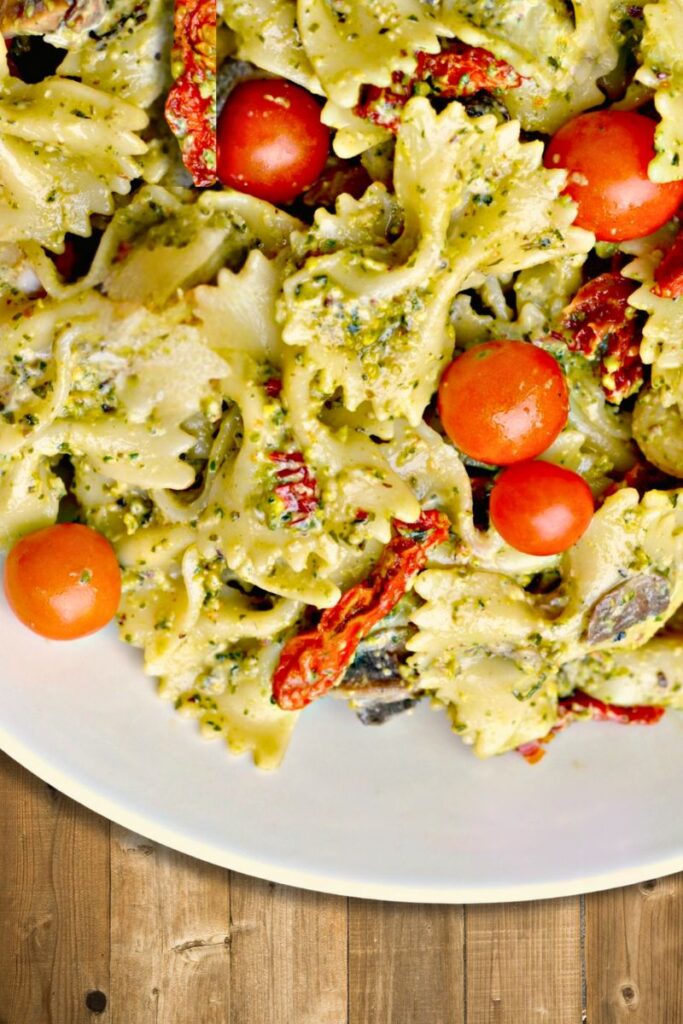
Regional Twists
- Sicilian Style: Incorporate sun dried tomatoes, capers, and a pinch of red pepper flakes
- Provençal: Add roasted red peppers, niçoise olives, and fresh thyme
- California Fusion: Include avocado chunks, grilled corn, and cotija cheese
- Mediterranean: Mix in artichoke hearts, feta, and oregano
Seasonal Adaptations
- Spring: Incorporate blanched asparagus tips and fresh peas
- Summer: Add grilled zucchini and yellow squash
- Fall: Include roasted butternut squash and toasted walnuts
- Winter: Mix in oil packed sun dried tomatoes and roasted bell peppers
For a delightful twist on traditional pesto, consider substituting half the basil with another herb like mint, parsley, or arugula. Each variation creates a distinctly different profile while maintaining the fundamental pesto character. Arugula brings peppery notes, mint adds brightness, and parsley contributes clean, grassy freshness.
Conclusion
A truly exceptional pesto pasta salad balances tradition with personal creativity. Using quality ingredients and proper technique forms the foundation, but your own touches make it memorable. Unlike many dishes, its flavors often improve after a few hours as the pasta absorbs the herb infused oils.
Whether for a simple weeknight side or the centerpiece of a summer gathering, pesto pasta salad delivers sophisticated flavor with comforting familiarity, showcasing the Mediterranean philosophy of fresh ingredients, treated simply, allowed to shine.
FAQs
Can pesto pasta salad be made in advance?
Yes! Making it 2-4 hours ahead allows flavors to develop. For longer storage, reserve some pesto to add before serving, refreshing the bright flavors.
Why does my pesto turn brown?
Oxidation causes browning. Prevent this by blanching basil, adding extra lemon juice, and storing with a thin olive oil layer on top.
What’s the best pasta shape?
Choose shapes with ridges or twists that capture sauce fusilli, farfalle, orecchiette, and rotini work beautifully. Avoid long, smooth pastas.
Is there a dairy free alternative?
Try nutritional yeast with white miso paste for umami and depth. Soaked, pureed cashews add creaminess without dairy.


